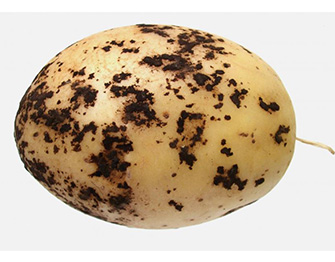Please click here to access the main AHDB website and other sectors.
- Home
- Knowledge library
- Black Scurf and Stem Canker
Black Scurf and Stem Canker

Rhizoctonia solani is a fungal disease causing stem canker, damping off, black scurf, skin netting and tuber growth distortions. Black scurf can be soil and seed borne and survives a long time in soil and on volunteers or crop debris. There is no significant proliferation during storage.
Symptoms
Affected roots, stems and stolons show reddish brown necrotic patches called cankers. A stem canker can cause symptoms similar to those of blackleg, in that plants are stunted and develop a rolling of the upper leaves. Brown, slightly sunken lesions with distinct edges develop on the stem base and on stolons. If severe, lesions can merge to girdle the stem. Later a white collar can develop on the stems at soil level. The resulting pruning of the stem can lead to uneven emergence and gaps in crops.
On the tuber black scurf is an entirely superficial black incrustation (sclerotia). It usually appears as small, irregular blemishes that can be extensive but easily scratched off. Long, fine, black strands (mycelia) may be associated with the sclerotia, are easily visible with magnification (10x). Affected tubers can show growth distortions that resemble glyphosate damage. Affected areas usually show retarded growth in association with thickened brown skin patches that are often referred to as netting or elephant hide. Other distortions include dimples and trumpet shaped holes penetrating the tuber.
Conditions
Disease development is generally promoted in cold planting conditions where plant growth is inhibited. Sprouts can be pinched off (damping off) but they often grow again from a point behind the severed tip. This gives rise to crops with a wide range of tuber sizes and maturity.
Control
An integrated approach to control is necessary as no single measure is entirely effective. There are no resistant varieties but seed should be clear of infection or fungicide treated. Measures which promote early emergence such as planting in warm, well drained seed beds minimise infection as vigorous plants will outgrow the infection. Avoid deep planting. Long rotations reduce disease levels in the soil.

